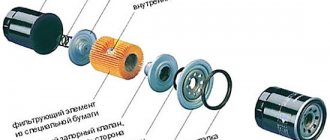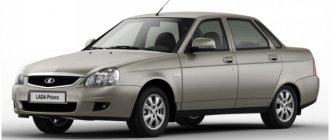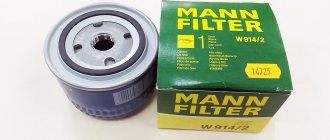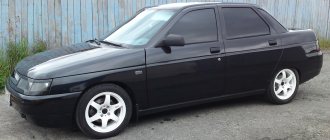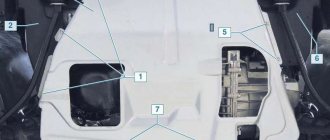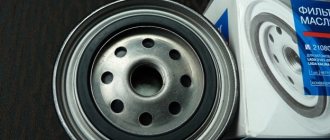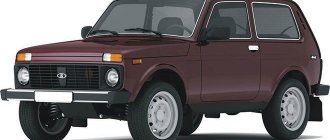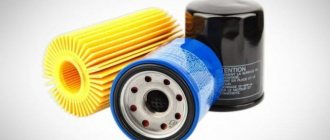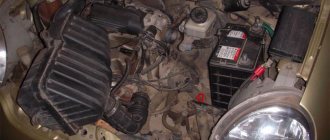Regardless of why you don’t want to go to a car service to change the oil in your car’s engine, the oil will still have to be changed after a certain period of time (mileage). And with it the oil filter. And this filter sometimes gets stuck so that even though you wrap it by hand, it is not possible to unscrew it without special tools. In our article we will offer four effective ways to unscrew the oil filter without a key or a special puller in a regular garage.
What happens to the car if the filter is clogged?
Untimely replacement of the oil filter on Logan can significantly affect the operation of the oil system and the engine in particular.
Chips from friction of the surfaces of parts, dirt and dust from routes - all this passes through filtration along with the engine oil and enters the engine. The operating period of oil filtration is one year. The manufacturer recommends changing consumables every 15-20 thousand kilometers or once every 12 months. At the same time, once every six months you should look into the system and check the condition of the spare part. It is not always possible to follow the manufacturer's instructions - the operation of the filter is influenced by many factors that significantly reduce its service life.
Signs of a clogged filtration:
- fuel consumption increased;
- the car stalls and moves jerkily on inclines;
- engine power and thrust decreases;
- oil leakage, which leads to clogging of the element;
- slipping at idle;
- uncontrolled braking of a vehicle;
- difficult to start the engine the first time;
- the dynamic characteristics of the engine are reduced.
If you change the filter in a timely manner, as it wears out, you can prevent unwanted global repairs, which are ten times more expensive than the corresponding replacement process. By choosing a high-quality spare part, you can ensure uninterrupted cleaning of the engine fluid from decay products and dirt for a certain service life of both the engine oil itself and the filter device.
The most important failure of a part is damage to the housing or filter cassette. If the cassette is easy to replace, you just need to buy a new one and carry out repairs, but the body itself is difficult to change - due to its inconvenient location, a thorough repair will be required. If you strictly follow the recommendations described in this article, you can easily cope with replacing the oil filter on a Renault Logan alone.
Is it worth paying extra for the brand?
The instructions for replacing the oil filter in your vehicle's manual require the use of original oil filters recommended by the manufacturer. The advantages of the original are a guarantee, full compatibility and quality workmanship. There is only one minus - the price.
The secondary market has one main advantage - low cost. There are many disadvantages. These are low-quality materials, rough processing, and sizes that do not match the original. Often, saving money on a filter can lead to losing a lot of money on repairing an engine damaged due to the use of a low-quality filter, which may not clean the oil at all. It is better to choose filters from reputable brands such as Bosch, Filtron or Goodwill.
Oil filter design
The filter element is the main component of any oil filter. To clean engine oil, a piece of special paper is used, which is a thick layer of a combination of the thinnest threads of cellulose, plastic and glass. To give the filter material strength, rigidity and the necessary physical and chemical properties, it is impregnated with a composition based on phenol-formaldehyde resins.
After this preparation, the paper tape is folded like an accordion and wrapped around a perforated metal tube. A cylindrical corrugated filter is formed - a filter element, the ends of which have the shape of a star with many rays. A thin metal ring is tightly glued to each end of the corrugation, which tightly covers the cylinder of filter paper. The impermeability of unfiltered oil to leak depends on the quality of the adhesive (resistance to gasoline and oil) and the density of its layer. This removes mechanical impurities from the oil.
The filter also serves to ensure that a certain amount of oil remains in the engine oil cavities after stopping the engine. This role is played by a check valve in the form of a wide, complex rubber cuff configuration. When the engine is running, oil pressure lifts the flexible edges of the cuff and flows into the system. When the engine stops, the oil drains into the crankcase and its weight presses against the cuff, preventing it from draining further. The oil system remains partially filled.
Many parts have a bypass valve that allows cold oil to flow directly into the oil system when the starter is cranked in the morning. This is necessary to make it easier to start the engine, since in this case the oil passes through the filter.
When and why to change the filter
Oil flow diagram in a full flow oil filter
Over time, the filter element collects the maximum amount of impurities and ceases to perform its main function. There is only one way out: replace the old oil filter with a new one.
In special cases, earlier replacement is required. If the check valve is made of poor quality rubber and no longer seals the oil system, the part must be replaced immediately. This may be indicated by a prolonged burning of oil pressure while the engine is running. One of the reasons for its fire may be an empty oil system. The consequences can be very sad: while the hoses are filled with oil, the rubbing parts work without lubrication. This can lead to increased wear of the mating parts or jamming of the crank mechanism.
If you continue to drive with a dirty filter, you can quickly kill the engine. The fact is that clogging the filter element will not affect the circulation of the lubricant in any way. Filter bypass due to operation of the bypass valve. In this case, it will not be cleaned to the rubbing parts. The power unit will begin to wear out intensively and the oil pressure indicator will not light up. This situation is specially designed in the filter device. The developers determined the service life of this device to be 10 thousand kilometers, which coincides with the service life of high-quality motor oil.
The oil change rules of all car manufacturers provide for the simultaneous replacement of the oil filter. The fact that it is clogged can only be guessed by indirect signs. Firstly, you need to pull out the dipstick more often and visually assess the degree of oil contamination. Secondly, listen to the engine and monitor its operation. With intensive wear of the connecting rod and piston group, extraneous noises and knocks may appear, and the car will become less responsive.
If you change the oil and oil filter yourself, pay attention to how much comes out. A small number of tests will tell you that the check valve operates reliably, which contributes to engine longevity. Since the design of parts in passenger cars is inseparable, they are simply removed after a period of operation. There is no point in washing it with any solvent, since it is impossible to clean the paper from dirt. In trucks, the oil filter is folded and only the filter element is replaced.
It is important to understand that reliable operation of the oil system depends on the coordinated operation of all its components. And the oil filter is one of the most important elements for its effective operation.
How not to make a mistake with your choice
Today, in order not to make a mistake in choosing an oil filter, you need to buy the original brand, which is placed on the assembly line of the manufacturer’s plant. And if there is another brand, then only on the recommendation of official dealers. This is safety. It is associated with a large number of different options for cheap filters from unknown manufacturers, differing from each other not only in price, but also in size, valve adjustments, quality of filter paper and quality of individual design elements.
Potential risk to engine longevity
And although many manufacturers of inexpensive filters try to copy the production technologies of the original cleaning devices, they often do it incorrectly. Wrong glue; the paper is incorrect or not folded well; poor quality rubber in the check valve; not a sealed bypass valve or vice versa, which only opens when the critical pressure is exceeded. Such filters do not work well, do not cultivate the necessary resources and can cause enormous damage to an expensive power unit.
The main difference between original oil filters and non-original analogues is that when designing an original filter, the main emphasis is on the correct operation of this important device and its long-term operation. Aftermarket engine lube filter manufacturers are primarily concerned with reducing the cost of manufacturing their products.
Bypass valve - protects against dangerous increases in oil pressure
I would especially like to say about the role of the bypass valve. Its main task is to direct the flow of oil through the filter, thereby preventing a critical increase in oil pressure in the engine lubrication system. As a result, oil seals and gaskets are protected from damage. The increased risk comes from cold oil - it has a very low viscosity - and from a very dirty filter fold that does not allow the oil to flow freely through the clogged paper. However, a bypass valve installed on the oil pump also helps solve the problem of starting a cold engine.
Bypass valve location
Many oil filters have a bypass valve at the top (opposite the end of the mounting thread). Practice has shown that this is not the best place. After starting the unit, thick oil enters the oil system, bypassing the oil filter. To do this, the valve passes lubricant directly into a central channel that fits into the inside of a perforated steel tube, flushing the dirty end of the filter element. Oil filter manufacturers corrected this problem and began placing a bypass valve in the passage at the bottom (at the end with the filter thread threaded into the cylinder block). The position of the regulator can be checked by looking inside the threaded hole. If the valve is clearly visible, it is located inside the filter above the end of the filter element. If only the spring is visible, it is inside the filter element.
In expensive car models, there is no check valve or bypass valve in the oil filter. Protection against overpressure and oil drainage is built directly into the engine oil system. Therefore, buying products from unverified contractors for such prestigious cars is unacceptable, expensive and very risky.
Interchangeability of oil filters for gasoline and diesel engines
The lubricating properties of carburetor and diesel engines are very different from each other. Therefore, the settings of the safety valves and the rubber properties of the drain (check) valves differ. Although the mounting thread for most filters is the same, installing an oil filter from a gasoline engine to a diesel engine (and vice versa!) is unacceptable.
The oil filter does not unscrew: what to do?
If you can’t unscrew the oil filter yourself, you can suggest that someone who has more strength try to do it. In most cases, you can unscrew even a strongly “stuck” oil filter without unnecessary tricks. But when you cannot unscrew the element even with outside help, you can use one of the methods described below:
- Special wrench for oil filters. In automobile accessory stores you can find a special wrench designed to unscrew oil filters of various diameters. It is enough to hook such a key onto the element and then start rotating. Using it to unscrew the oil filter is not difficult, but not all drivers have such a key, and you must first purchase it;
- Creating a lever. In the garage you can always find a lot of unnecessary parts and various tools from which you can build a lever. For example, you can put an old timing belt or generator belt on the key, then tie it around the filter and start rotating. Due to the unique lever and the absence of rubber sliding on the oil filter, unscrewing the element will not be more difficult than using a special wrench;
- Screwdriver and hammer. A simple and effective method that is suitable if you are not afraid of getting dirty in oil. It implies that a screwdriver must be driven through with a hammer into the oil filter. When the filter is broken, you can use a screwdriver as a lever, unscrewing the consumable element. It should be understood that if the oil filter is broken, residual oil will flow out of it;
Please note: Some drivers recommend not punching through the filter with a hammer, but rather driving a screwdriver into the area of the mounting location with a hammer. Doing this is quite dangerous, since the screwdriver may accidentally fall off and pierce the engine components.
(439 votes, average: 4.57 out of 5)
The starter turns for a long time when starting the engine
Wipers squeak on glass: main reasons and troubleshooting tips
Related Posts
Crab type puller
It is a kind of semblance of a planetary mechanism: one central cylindrical gear and three satellite gears of the same size and type, each of which meshes with the first.
The outer gears are located around the central one evenly around the circumference, that is, at 120 degrees to one another. All of them are fixed with their axes on a strong and rigid round disk and a triangular plate with rounded corners on the back of the gears.
The central gear is driven into rotation by a wrench through a nut located with the face of the plate on the extension of the axis of the central gear. At the same time, the side satellite gears also begin to rotate within less than one revolution around their axis, which is quite enough for the operation of this type of clamp.
The oil disc housing is clamped using L-shaped brackets of circular cross-section, which are welded with the short side perpendicular to the generatrices of the side gears directly in the center, so that the angle between them is also strictly 120 degrees. Moreover, the long rods of the brackets should be parallel to each other and oriented in the direction opposite to the location of the nut. For better grip, the long sides of the staples, from at least the middle to the end, are equipped with a protruding longitudinal notch.
If the staples are positioned radially, then the conventional cylinder inside them has a maximum diameter. Rotating the nut to the left or right brings the brackets closer together, and the diameter of the conditional cylinder decreases.
Using this device is quite simple: grab the oil filter housing with brackets and use a wrench to turn the nut to the left, thereby twisting the filter from its seat. When you rotate the nut to the right, the filter will, on the contrary, tighten.
Selection of oils
Now to the question of what kind of oil to pour into the engine of the French Renault Logan car. According to the recommendations of the automaker itself, oil produced by Elf is optimally suited for their cars. They work closely together, which is why only this liquid is indicated in the instruction manuals.
The main recommendations for this car are two oils from Elf from the Evolution series:
Also in demand are:
- Turbo Diesel 10W40;
- Competition ST 10W40;
- Solaris RNX 5W30;
- Excellium LDX 5W40, etc.
Elf's line of motor oils includes universal lubricants, fluids designed for specific engines, as well as separate series for automatic and manual transmissions.
If you ask the owners of such cars about what kind of oil they use, the majority is inclined to think that Renault’s recommendations are correct, and the engine works well with these oils. There are also experiences with unsuccessful oil changes.
As for the type of oil, there are 2 options to choose from.
- Semi-synthetic. It is better to use it on cars whose mileage is already more than 100 thousand kilometers. Its thicker consistency helps prevent leaks through worn gaskets and seals. Well suited for winter as it easily starts the engine at low temperatures.
- Synthetics. Suitable for newer cars. Synthetic lubricants are recommended for use on all modern cars and their engines. Great fluidity and stability of physical and chemical characteristics guarantee protection against overheating, wear and frost.
Therefore, focus on the age and mileage of your Renault Logan when choosing between synthetics and semi-synthetics. Just keep in mind that when changing the oil, be sure to change the following in parallel:
- oil filter;
- gasket for the drain plug (made of copper).
This will allow the engine to run better with fresh oil and prevent unwanted lubricant leaks.
Changing the oil in the Renault Logan 2 engine
Changing the engine oil is a process that, according to the manufacturer of Renault Logan 2, should be done once every 15,000 km. If the annual mileage is less, then new working fluid is added to the engine once a year. Simultaneously with replacing the engine oil, other elements are also replaced - the oil filter (required) and the drain bolt washers (depending on their condition). The catalog number of the original washer is 110265505R.
The Renault Logan 2 manufacturing plant fills various engines with Elf Excellium LDX 5W40 oil. In the future, when replacing, the following engine oils are recommended:
- For engines with eight valves, Elf Evolution SXR oil with a viscosity grade of 5W30 is suitable. The required volume of lubricant for replacement is 3.3 liters.
- For 16V (K4M) engines, Elf Evolution SXR is used, with a viscosity grade of 5W40. Here it is advisable to prepare 4.8 liters of working fluid.
If you choose an alternative option, you should pay attention to motor oils that comply with the following API classes - SL, SN and SM, as well as ACEA A5 and A3. When determining the appropriate lubricant viscosity for your engine, you must base it on the temperature that prevails in your region:
When determining the appropriate lubricant viscosity for your engine, you must base it on the temperature that prevails in your region:
- At temperatures of 30 degrees below zero and above, it is recommended to use SAE 0W30 or 0W40 oil.
- If the thermometer in winter does not fall below 25 degrees below zero, then compositions with the following SAE viscosity are suitable - 5W30, 5W50 and 5W40.
- For regions where winter does not get colder than 20 degrees below zero, motor oils with the following SAE viscosity are suitable - 10W30, 10W50 and 10W40
Currently reading: Comparison of Renault Logan and Renault Logan Stepway by characteristics, cost of purchase and maintenance.
Which is better - Renault Logan or Renault Logan Stepway Car owners often prefer Excellium NF 5W40 oils, but when choosing this brand, changing the oil to a composition with a W30 viscosity is prohibited. The reason is that a lubricant with a higher viscosity cokes more.
Changing the oil and oil filter for Renault Logan 2
Engine 1.6 8V (K7M) 1. Place the car on an inspection ditch or overpass. 2. Unscrew the oil filler cap.
3. Use an 8 mm square wrench to loosen the drain plug.
4. Place a container for used oil under the engine, unscrew the plug and drain the oil from the engine into the container.
5. Loosen the oil filter using a puller from the top of the engine compartment.
6. Unscrew the oil filter by hand and remove it.
7. Using a clean rag, carefully clean the landing surface of the oil filter on the cylinder block. 8. After the oil stops flowing out, screw the plug into the drain hole, replacing the washer if necessary. 9. Apply clean engine oil to the rubber o-ring of the filter. 10.
We screw the filter into place until its sealing ring comes into contact with the mating plane of the cylinder block. From this position, tighten the filter 1/2 -3/4 turns. 11. Install a funnel in the filler neck and pour engine oil into the engine crankcase, monitoring its quantity using the oil level indicator. 12.
Install the cap on the oil filler neck. 13. Start the engine and make sure that the emergency oil pressure indicator lamp has gone out. and there are no oil leaks from under the oil filter O-ring and from under the drain plug. 14.
Engine 1.6 16V (K4M) 1. Place the car on an inspection ditch or overpass. 2. Unscrew the oil filler cap.
3. Remove the engine crankcase protection (see here).
4. Use an 8 mm square wrench to loosen the drain plug.
5. Place a container for used oil under the engine, unscrew the plug and drain the oil from the engine into the container. 6. From the bottom of the engine compartment, use a puller to loosen the oil filter.
7. Unscrew the oil filter by hand and remove it. 8. Using a clean rag, carefully clean the flattened surface of the oil filter on the cylinder block. 9. After the oil stops flowing out, screw the plug into the drain hole with a new washer 10. Apply clean engine oil to the rubber o-ring of the filter (see above). eleven.
13. Install the oil filler cap. 14. Start the engine and make sure that the emergency oil pressure indicator lamp has gone out (it may stay on a little longer than usual), and there are no oil leaks from under the oil filter O-ring or from under the drain plug. 15.
The instructions are intended for Renault Logan 2022, 2021, 2022, 2022, 2022 models.
Cleaning steps
Cleaning the air filter
- Vacuuming the filter is much faster and safer than washing it.
- If necessary, wash the dry filter. Fill a bucket with a solution of soap and water. Place the filter in a bucket and shake. Remove the filter and shake off excess water. Rinse the filter thoroughly under running water. Place the filter on a towel and let it dry completely.
- Do not insert a wet filter back into the housing! This may damage the car's engine.
- Wet filter cleaning is much more effective than dry cleaning, but at the same time more risky and time-consuming.
Cleaning the oil filter
- Tap the filter to remove dust and dirt. Apply a cleaning solution (specially formulated for oil filters) to the inside and outside of the filter. Make sure the filter is completely saturated with the solution. Leave in the sink or bowl for ten minutes. Rinse the filter with cold water under low pressure. Shake off and let dry completely.
- Make sure that the detergent does not dry out on the filter - leave it for ten minutes.
- Rinse the filter by moving it up and down under running water.
- After rinsing, the filter should dry in about fifteen minutes. If it does not dry completely within this time, wait a few minutes.
- If you're in a hurry, turn on a hairdryer or small fan on medium speed and heat to speed up the drying process.
- Lubricate the filter if necessary. Spread the oil evenly over the surface of the air filter. Coat the filter thoroughly with a thin layer of oil. Wipe off excess oil from lid and bottom edge. Leave on for 20 minutes to allow the oil to absorb.
- Clean the housing. Vacuum the filter housing with a special attachment to remove all dust and dirt from it. Alternatively, you can use a soft cloth or paper towel. Before replacing the filter, make sure the housing is completely dry and clean. Moisture and debris can damage the engine.
- Replace the filter. Place the filter back into the housing. Secure any clips or latches that held the filter in place when you removed it.
Cleaning the Internal Air Filter
- If the system is not turned off, it will attract debris during the cleaning process.
- If the vent is on the ceiling or high on the wall, use a ladder.
- Remove dirt. Shake out any dirt from the filter into the trash. Install the crevice tool on the end of the flexible hose. To remove dust and debris, vacuum the front, back, and sides of the filter with the upholstery attachment.
- If possible, vacuum the outside of the filter to keep your home dust-free.
- Rinse the filter under running water. Place the hose on the faucet. Hold the filter so that the water flows in the opposite direction to the air flow. Rinse the filter thoroughly to remove dust and dirt.
- For tougher stains, wash with soap and water. If simply rinsing is not enough, try soaking the filter in soapy water. In a bowl, mix a drop of dishwashing liquid and two cups of warm water. Stir the solution. Soak a cloth in the solution and wipe the filter on both sides. Rinse the filter with water and let it dry completely.
- Shake off any remaining water before letting the filter dry.
- If grease, smoke, or pet hair gets into the filter, wash it with soap and water.
- Dry the filter thoroughly. Pat dry with dry paper towels and let it air dry. Make sure the filter is completely dry before reinstalling. If you ignore this rule, mold may form in the filter.
To reduce friction between the contacting parts of a car engine, oil is poured into the engine compartment. However, when contaminated, it loses its beneficial properties. To extend the service life, the lubrication system uses an oil filter - a part that also requires periodic replacement.
Replacement instructions
Changing the oil on a Renault Logan yourself does not require any special skills or any knowledge. Try to act carefully, consistently and do not forget about safety measures. First, we note that the replacement procedure on 8-valve 1.4 and 1.6-liter engines is slightly different from the 16-valve engine, so we will consider it separately. Let's start with 8-valve engines.
To work, it is better to park the car in a pit. Some people make do with a jack, but this is dangerous and inconvenient. Having placed the car over the pit, place chocks under the wheels and turn on the handbrake on your Logan. It is better to remove the negative terminal from the battery, since there is a high voltage wire near the filler hole.
To make the lubricant flow out faster, increase the fluid fluidity level by warming up the engine a little. This will make the oil change more intensive, plus you will be able to get rid of the maximum amount of old lubricant in the engine. Do not overheat the engine, otherwise hot oil will end up on your skin when drained, causing serious burns.
Up to 50 degrees is enough. Unscrew the plug for filling in fresh oil to eliminate vacuum when draining old lubricant. He finds a drain plug under the car. The cork is unscrewed with a 4-sided tool, the holes for which are usually dirty. So clear them and insert the key
An important feature of these motors is that it is not necessary to remove the engine protection to drain the liquid. There is a special hole for easy access to the neck.
Carefully loosen the plug and turn it 2–3 turns.
Now we substitute an empty container for drainage and unscrew the plug completely. Be careful not to let the oil spill on you. This is why rubber protective gloves are needed. While the grease is flowing out, take the oil puller and remove the old filter.
It is located in the front part near the exhaust manifold. Clean the filter seat and remove the old gasket. Before installing, lightly lubricate the rubber ring on the new filter with oil. Fill 50% of its volume with fresh lubricant inside the filter itself.
When the oil is drained, wipe everything with a rag, be sure to change the copper ring on the plug and screw it into place. Here, too, medium tightening efforts are needed. We begin to fill in fresh engine lubricant. 8-valve engines of 1.4 and 1.6 liters. First add only 3 liters.
We add everything else, following the marks on your dipstick. When it shows the level halfway between o and "Max", close the cap and warm up the engine for 20 seconds. The oil lamp on the instrument panel should go out. 10 minutes after turning off the engine, take the dipstick again and check the level. If necessary, add a little oil.
The procedure is simple, but requires your attention and compliance with safety rules. Replacement is carried out literally in 1 hour.
How to unscrew the oil filter with a special wrench
There are many types of pullers. Here is a description of some of them:
- Tape. Handle with a grip in the form of an open ring made of steel tape. One end is attached through a hinge to the handle itself, the second - through a hinge to the movable rocker arm. When you turn the handle counterclockwise, the rocker starts to move, the ring moves together, decreasing in diameter, the tape wraps around the filter body and sets it in motion.
- Belt. The principle of operation is very similar to belt ones, but only one end of the belt is attached to a hinge to the rocker arm. The second one is free. The free end is wrapped around the body, passed into the rocker arm, and the belt is “pinched” by turning the handle counterclockwise. Continuing the movement of the handle, unscrew the stubborn element.
- Chain. A loop from a chain, similar to that from a timing belt or bicycle, is clamped in a head with a hole for the square of the handle from the set with socket heads. They wrap the filter in a loop, insert a square into the head, and wind the chain around the head until it clamps the housing and turns it.
- Ticks. Keys modeled after pliers. They consist of two handles with semicircular toothed girths on a hinge joint. They work like a locksmith's analogue.
- Crescent-shaped. With one handle, one movable serrated girth and a fixed short serrated end. A simplified version of the previous key.
- End, cup-shaped. Puller heads. For professionals, they are sold in the form of kits for different sizes of oil filters. You can buy only one for a specific car make and type of filter element.
- Crabs. They belong to universal end pullers with three movable self-clamping “legs” at an angle of 120° relative to each other. They are activated, like the cup-shaped ones, by a square inserted into the hole at the end of the key.
The fourth method is a hammer and chisel
Another fairly simple way to unscrew the oil filter without a key. To do this, we don’t need anything else except the chisel itself with a sharpened tip and a hammer. How we do it:
- Place the sharp end of the chisel on the rim of the filter bowl on the side adjacent to the engine.
- We position it at such an angle that at the moment of impact it could tear off the oil filter, that is, counterclockwise.
- We hit the chisel with a hammer. Didn't it break? We move the chisel a centimeter further and hit again.
Eventually the filter will turn and the part can be turned out by hand. If anything remains unclear, watch the video.
What is the best oil to put into the engine?
The necessary data on the frequency of engine oil changes, the recommended brand and quantity are usually indicated in the user manual or technical passport of the car. Before you start changing the oil, it is advisable to read this documentation.
Despite the variety of motor oils, it is still worth adhering to the recommendations of the car manufacturer. However, this does not mean at all that it is necessary to purchase exactly the officially recommended oil recommended by the Renault concern - it is not the brand of oil that plays an important role, but its specifications.
Currently reading: MRLOGAN7612 MANOVER Oil filter puller cup 76mm 12-gr VAZ LADA Largus, RENAULT Logan (MANOVER) MRLOGAN7612
Renault on its official website recommends ELF oils for warranty and after-sales service.
After determining the manufacturer's recommendations, it is advisable to find out what was poured into the engine before. If the car is just yours, then there will be no problems with this. If the vehicle was bought secondhand, then it is worth checking with the previous owner what brand of motor oil he used.
Constantly changing the oil has a negative effect on your car's engine. Accordingly, it is advisable to select either the brand of oil that has already been filled in, or one that is close in terms of the characteristics indicated on the packaging to the manufacturer’s recommendations. However, there are times when it is still worthwhile to change the oil to another brand - for example, if its consumption is too high.
In such situations, it is better to choose high-viscosity oil. By the way, this or that type of engine oil is indicated not for a specific car, but for the engine installed in it. Accordingly, the oil is selected based on the additives and properties allowed for the engine.
Ideally, you can purchase the required engine oil from an authorized Renault dealer in the city. Of course, this option is very expensive, but it’s still worth asking about prices - official dealers often offer significant discounts to regular customers.
Inconveniences for the driver
Car modifications have individual principles for attaching the oil filter. What remains common is the lack of space around them, since the layout of the power units is so compact that it is almost impossible to “crawl” in to screw together the oil cup. Difficulties include the adhesion of rubber seals to metal.
Based on the above, they conclude that a specific engine requires “its own” device or universal puller. When developing your own design, you need to focus on factory analogues of oil filter pullers sold in car dealerships.
Volume of oil to be filled and checking it
Based on the official factory instructions, the amount of oil poured into the engine depends on the number of valves on the engines and their volume. Therefore, be guided by the following data:
- for Renault Logan engines with 16 valves with a volume of 1.6 liters. 4.5 liters of lubricant required;
- if it is a 1.4 and 1.6 liter engine with 8 valves, then prepare at least 3.35 liters of lubricant.
The level is checked for preventive purposes during vehicle operation. Some do this almost every day, others use the dipstick to determine the engine oil level only once a month, or even less often. Every car owner is required to monitor the oil level in his engine. It should always be at the optimal value, which guarantees effective lubrication of all components.
If the oil in the Renault Logan engine begins to leak, the level will gradually drop. This should definitely be checked. Almost every motorist knows how to do this. You need to take out the dipstick, wipe it dry, insert it back, twist it a little and pull it out.
You can also take a few drops of oil with a dipstick every 2–3 months when the machine is actively used and drop them onto a white cloth or paper. This way you will see if there are any extra particles, how clean the oil is and whether its color has changed. Such changes indicate premature wear of the lubricant, which should be changed.
Just keep in mind that the loss of a lubricant’s physical and chemical properties ahead of schedule indicates the presence of some problems in the engine itself. Therefore, before pouring several liters of new lubricant, it is recommended to check the condition of the power unit for malfunctions. Otherwise, the same thing will happen with new oil.
Reasons to buy original filters and consequences of using counterfeits
When choosing between genuine and counterfeit devices, always remember that manufacturers of non-genuine products are primarily concerned with reducing costs.
Reasons for using original filters:
- They are fully compatible with the specific vehicle.
- They are distinguished by high quality workmanship.
- You don't have to worry about losing your warranty.
Reasons why drivers are forced to use non-original filters:
- High cost of the original model.
- Long wait for delivery of original product.
Using the wrong filter will save you money at some point. But this ultimately leads to even greater costs. Poorly refined oil will definitely lead to serious problems with the car engine.
Abrasive particles enter the engine along with the oil. The coefficient of friction between the various moving parts of the engine increases. This causes the engine to overheat, which can lead to seizure.
Using a poly V-belt to unscrew the filter
Surely many people have a used drive belt for a generator or air conditioning compressor; this is a rubber belt with longitudinal grooves. A timing belt can also be suitable, which can also effectively wrap around the filter body. Next, unscrew it using several methods.
If the filter can only be accessed from below, like I do, then you can put the belt in regular pliers, wind the free part of the belt around the filter, then rotate the pliers and wind the rest of the belt around the jaws of the pliers, when it gets taut, you can rotate the pliers themselves around the filter, which give more force to unscrew than trying to do it by hand.
This method is discussed in more detail in the video clip, which is located just below all the methods on the topic of belts.
In general, there are a lot of methods associated with unscrewing an oil filter using a belt; it can be inserted into a long head and transmit rotational motion to the head through a wrench, which will provide even greater unscrewing force. To insert the belt into the head, you need to make a slot on both sides with a grinder, into which the strap itself will be inserted.
To fix it, you can use a bolt, but if you do it very carefully and correctly calculate the width of the slot, then the timing belt can be held in it independently due to the teeth. More details about the manufacture of this equipment can be found in the video at the very bottom of this article.
You can insert the belt into a small square tube that will be used as a handle (lever). The released part of the belt is fixed by hand on a “square handle” or in another way (for example, hammering in a wedge), and then the filter is rolled up. But here we also need to take into account that there must be space around the filter.
Currently reading: Renault Logan remove replacement repair Maintenance Renault Logan
You can also insert the belt into a closed (spanner) wrench and use it as a wrench to roll the filter from a dead point. This is quite simple to do, but you need to have free space around the filter.
https://www.youtube.com/watch?v=wpOE31kUnjQ
I assembled a video clip from the methods described above for unscrewing the filter using belts. They show more clearly the essence of the solution to the problem that has arisen. Removing the filter with a homemade chain puller Methods associated with reconciling the chain are somewhat more complicated, since, in fact, they require the creation of a more complex device than was used with a belt. Below I will talk about a couple of methods that are available for quick production of equipment, provided the materials are available.
You can take a bicycle chain and a piece of pipe, then drill a hole in the pipe for a bolt or any other object that will serve as a locking pin. The idea is as follows: we put the chain on the filter, insert the remainder into the pipe with the hole, slightly stretch the chain and insert into the hole on the pipe any fixing element that must pass between the chain links for fixation. Next, we apply force to unscrew the filter; the chain links dig into the body of the filter and does not slip even if the latter is stained with oil. You can learn more about the application of this method in this video.
On YouTube, I came across an excellent video on how to independently make pullers of several types from a belt and chain, but making them in a home-made environment will lead to a colossal amount of time, while the output can be obtained with suitable products.
I would also like to say that such factory-made devices are not so expensive and at home it is easier to use homemade devices with a belt or buy a ready-made filter puller.
The production of such pullers is relevant in a car service center, when there are free chains and heads that are no longer useful due to their wear or low quality.
Replacement process
Replacing the oil filter on a Logan is carried out in several stages: the engine oil is drained, the gasket on the plug is changed and, accordingly, a new filter unit is installed. It is best to carry out the process on an overpass or pit so that you can freely climb under the hood. Operating time: no more than 15-25 minutes.
For repair you will need:
- special puller;
- container for used motor oil;
- new oil element;
- hammer and screwdriver;
- key for 10 and key for 17;
- key for the drain plug;
- canister of suitable motor oil.
The location of the part on a Renault Logan car requires the observance of certain precautions: in particular, carry out repairs in overalls and gloves and do not touch other parts if the engine has been preheated.
The process of replacing the oil filter in Renault Logan:
- Unscrew the bolts on the filter cover with a wrench;
- Loosen the tightening on the drain plug;
- place a container under the motor;
- wait until the used lubricant is completely released;
- Screw the plug tightly with a wrench and screw on the drain plug;
- unscrew the old unit. It's better to use a puller. Before unscrewing, clean the attachment point;
- We wipe the seat with a rag;
- apply new grease to the sealing ring;
- Fill the new unit with oil to the middle;
- manually tighten the spare part;
- pour 3.4 liters of liquid through the filler plug;
- tighten the filler plug with a 17 mm wrench;
- start the engine and check the special low pressure sensor;
- inspect the work site and add lubricant if necessary.
In a short period of time, by performing the repair process, you can extend the life of the oil system on Renault Logan.
What to do next?
When the old filter is removed, before installing a new one in its place, be sure to wipe the mounting area with a rag, pour oil into the filter itself, and do not forget to lubricate the rubber gasket with it. Only after this can the new part be considered ready for installation. Screw it into place (you don’t need to put much effort into this), turn on the ignition and let the engine warm up, while you observe the repair site. If everything is done correctly, oil will not ooze out from under the filter.
Lubrication system for k4m and k7m (k7j) engines
In general, the lubrication system is designed like this: there is an oil pump, which is driven by the crankshaft (timing mechanism), and it transfers oil from the sump to the main line. The first part installed in the line is the oil filter - it needs to be changed periodically.
If there is insufficient oil pressure, the switch contact opens and then the indicator is activated. Parts that allow diagnostics include the control dipstick - it is immersed in the engine sump. On motors K4M and K7M, the dipstick is located at different points: in Fig. 1 it is designated by the number 5, in the second figure – by the number 7.
List of important elements:
- Oil filler plug: element 7 (Fig. 1) and 1 (Fig. 2);
- Drain plug: located at the bottom of the engine sump;
- Oil filter housing: 19 and 6 respectively.
To unscrew the filter, you need a puller. If it is not there, a hole is made in the body closer to the bottom, and then an awl or screwdriver is used as a lever. The filter is dismantled after draining the oil. Before installing a new filter, on the contrary, it is filled with oil.
The drain plug is unscrewed with an 8 square. There will be a washer under the plug. A replacement is allowed - a copper washer with an internal diameter of 18 mm (advice from the magazine “Behind the Wheel”).
The original oil filter is suitable for all engines discussed here. Its number in the Renault catalog is 7700274177. Sellers, moreover, use the designation 7700274177FCR210134. And Renault has a filter 8200768913, which is also suitable. Good luck with your choice.
Oil filter puller. how to do it yourself.
Using the Renault Logan car as an example, it is shown how to make a simple and convenient puller for unscrewing the oil filter in a hard-to-reach place, as well as the procedure for changing the oil.
On a Renault Logan car, the oil filter is located on the front of the engine in a recess, opposite which the generator is located.
You can, of course, do it in a simple way: pierce the filter on the side with a screwdriver and unscrew it. For example, as shown in the photo below. But the engine will be flooded with oil, which not everyone likes.
You can use an oil filter puller from older car models that have fairly easy access to the filter. But to do this, in this car model you will have to remove the protective cover of the exhaust manifolds.
By the way, in order to unscrew the nuts holding the casing on a warm engine, it is advisable to cool them a little with a wet cloth. It will come off much easier.
You can purchase an oil filter puller of a suitable design, but this is also not always possible. One option looks like this:
There is naturally one puller in the package, it’s just shown on both sides. Yes, and also, there is a mistake on the packaging, its diameter is not 46 mm but 76 mm. This has been mentioned on many forums. Such a puller is strictly tied to the size and design of the filter, and if they differ slightly, the puller will not work.
A universal puller for filters with a diameter of 62 to 102 mm can be purchased here at a very reasonable price. It looks like this:
After looking on the Internet for various options for homemade oil filter pullers, I came up with the idea of making my own design. It does not require scarce materials and is quite simple to manufacture. You will need a metal strip with a width of 20 to 50 mm, a length of about 250 mm and a thickness of about 1 mm.
The edges of the strip need to be bent and two handles made of a rod about 10 mm in diameter and 20 mm long must be welded at an angle. If there is no welding, you can attach the handles with screws, having first made slits in the rods with a hacksaw or slightly flatten them with a hammer on the edges that will be attached to the strip. That's all.
Find out more about the new Logan
- Installing an armrest for Renault Logan and Sandero
- Fuses Renault Logan 2 (L8), 2014 - 2018
- Renault Logan alternator repair and replacement: pulley with air conditioner and how to remove
- Wheel alignment Renault - price in a car service 450 rubles (average) Moscow
- Renault Logan durability: engine life - New Logan
- Buy new Renault Logan at a price of 734,000 rubles in the Rostov region - more than 33 new Renault Logan on Avto.ru
- Adjusting the Renault Logan clutch - Auto magazine Acord-Auto | New Logan | New Logan
- Renault Logan idle speed sensor replacement for 1.4 and 1.6
